History of the Jats/Chapter XIII
| Wikified by:Laxman Burdak, IFS (R) |
1967 (Eng Tr by Lieutenant Colonel Dal Singh)
Printed at the Jaitly Printing Press, 147, Lajpat Rai Market,Delhi-6Jats, Ahirs, Gujars and Rajputs are the four chief martial races of India. Jat race, as has been proved earlier, is the oldest of these and gave birth to the others. Jats have inherited a brilliant record of warfare and warfare is now in their blood. Agriculture has kept them strong. Protection of their cattle from thieves and wild animals has kept up their bravery. Tales of heroism of their ancestors have kept up their spirit.
Jats as finest Soldiers
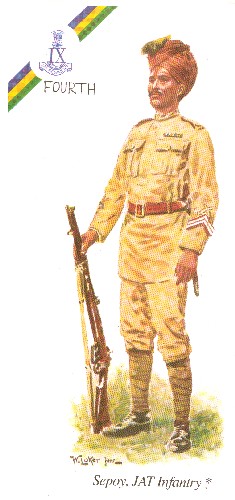
Jats make the finest soldiers. They are fearless and loyal. They are, however, sensitive and require firm and fair leadership. These qualities have been recognised by all high ranking British and Indian Army Officers who had an occasion to command Jat troops.
Jats as Officers
As officers Jats have shown outstanding qualities of leadership during World War II and in all actions fought by Indian Army after Independence, thus disproving the earlier British notion that although they produced good soldiers, Jats lacked the qualities of becoming Officers.
To quote General K M Cariappa from the foreward of this book, he says:
- "During my service in the Army I had on many occasions Jat soldiers and Jat units under my command. Their sense of duty, loyalty to the country, their efficiency as solders and their bravery as a class were all of the highest order. I have happy memories of these in these sons of our soil."
History of the Jats, End of Page-222
In June 1951, I with my friend Risaldar Harnarain Singh had gone to Dehradun to see the passing out parade of my son Dal Singh. General K.S. Thimmaya who was the commandant, addressing a Nepalese Minister present there, said:
- "I have served with Jats since 1927. What impressed me most was their ability to retain their sense of humour in the most adverse circumstances. Their numbers were increased in the Army as a result of their exceptional performance during the First World War."
Maj. Kingsley, a famous Jat squadron commander of 19th KGVO Lancer used to say that Jats respect a strong commander and cannot stand a weakling, however popular he may try to become. The biggest punishment for a Jat is to pardon him.
In 1934, during the reunion of 19th Lancers, Major Mostyn Owen complained to Risaldar Major Honorary Captain Inder Singh that he was harassed with the indiscipline of Sikh Squadron. Inder Singh retorted that a weak commander could never succeed with Sikhs and he would recommend to the C.O. to change him. The major apologized.
At least a score of present Jat gotras participated in the Mahabharata. Jats fought grim battles against Alexander the Great. In the 5th century A.D., under the leadership of Vir Raja Yashodharman, Jats gave a crushing defeat to the Huns. The Jat army of Harsh Vardhan conquered the whole of Northern India. Mahmood Gazni tasted defeat at the hands of Jats and Muhammad Gauri was beheaded by them1 Jats resisted the invasions of Babar and Timur and the excesses of later Muslim rulers. It is written on 214 of Chander Vidyalankar's book of history that when Nadirshah was returning from the plunder of Delhi, Jats waylaid him and looted the property back. It is on record of Jat Sarva Khaap that when Timur was watching the massacre of Delhi from a
- 1. not historically correct statement].
History of the Jats, End of Page-223
hillock near Raisina, Harveer Gulia, a wrestler of Gulia Jat gotra could not bear it. He took a dagger, single handed he crept close to Timur and pounced on him. He was killed by Timur's guard but left a record of unparallaled bravery. Jat Army of Bharatpur holds the rare record of never being defeated by the British forces.
Initially the Britishers distrusted Jats and did not recruit them in the Army of East India Company. After 1857, Britishers recognised the value of Jat soldiers and recruited them in large numbers. British Officers were so impressed by their sincerity and disregard for personal safety that some of them become Jats at heart. One of such Officers was Sir John Murray who raised 14th Murray's Jat Lancers.
14th Murray's Jat Lancers

This was the first Jat Unit raised by General Sir John Irvin Murray, KCB at Aligarh in 1857. He was earlier Superintendent Police, Meerut and there he had got impressed with the fighting qualities of Jats and their past history of resistance to Moghuls. He enrolled Kharak Singh of Mursan and the first Risldar Major. Kharak Singh contributed two squadrons complete with men and horses. Risaldar Mukh Ram of village Badli district Rohtak was taken as Risaldar and he came with one complete squadron. They exceptionally did well in all campaigns and earned a name for General Murray. He was so please that he started calling himself a Jat. He designed the Regimental full dress on the pattern of native Jat dress which he is seen wearing in his Portrait in the main hall of Jat Dharmsala constructed in his memory near Jumna Bazar in Delhi-6 from the proceeds of his entire property which he had bequeathed to the Jats.
To begin with Jats did not join the army for the sake of remuneration. They did so because they liked
History of the Jats, End of Page-224
glamour of army uniform and horses. Pay was, in any case nominal and those who joined Cavalry had to buy their own horses. When I joined 5th Cavalry on 1 May 1907, the pay of the foot soldier was nine rupees good conduct increment every third year. He had to make his own uniform and also pay for the services of barber, dhobi, etc. A sawar got twenty one rupees per month. Out of this he had to pay for his own ration and that of his horse and one mule between two, half pay of the syce maintenance of barracks shoeing of his horse and the service of barber, dhobi, etc. When I got enrolled I had to deposit Rs.500/- as an advance for getting the horse and the mule. I got saddlery on installments. About four or five soldiers used to get together and do combined cooking.One could use the langar but the cooking was of a very poor standard. With two and a half ears of service I became acting Lance Dafedar. Cuttings increase with the rank and I could save only eight annas at the end of the month. I thought it was not worth serving for and applied for discharge. My Squadron Commander Major Williams used the good old theme on me that Jats didn't join for pay and that I should look forward to becoming the Risaldar Major of the Regiment one day. I stayed on and served for 39 years and 4 months. Thus the saying became truth.
Cavalry has been and still remains the favourite arms for the Jats. When the first World war [1914-1918] started there were 12 squadrons of Hindu Jats and 15 squadrons of Sikh Jats.There was a majority of Muslim Jats in the muslim squadrons also. On the out break of second world war [1939-1945], Cavalry regiments were mechanised and equipped with tanks and armoured cars. The regiments held a ceremonial 'Last Mounted Parade' and said a sad Good Bye to the horses.The momentous photographers of these parades lie in albums as everlasting memories of the Cavalry glamour which had so readily attracted Jats. Jats, however, continued the tradition and even now provide the
History of the Jats, End of Page-225
maximum share of men to the Indian Armoured Corps.
In the infantry Hindu and Sikh Jats provide two complete regiments i.e. the Sikh regiment and the Jat Regiment and half the share of men to the Rajputana Rifles, the Grenadiers and the Punjab regiment. In addition to this Jats are found in good number in Brigade of the Guards and other arms and services.
All units comprising of Jats hold unparralled record of gallantry in both the world wars and post independence action of the Indian Army. This is well known and a description of their great deeds is beyond the scope of this Book. In this chapter I have collected extracts of the outstanding achievements of Jats Units and individual officers and men. These are all which have come to my notice. The list is by no means exhaustive. Additions to in future editions will be welcome from the friends and relatives of those whom I may have missed.
Jemadar Gopal Singh
Jemadar Gopal Singh was the younger brother of Risaldar Mukh Ram and had been directly enrolled directly as Jemadar. In 1878, in the second battle of Kabul C Squadron was ordered to charge a maize field from which heavy fire was coming. Jemadar Gopal Singh's troop got bogged in the mud of the watered field. Pathans shot down all his men in this helpless situation. Gopal Singh's horse managed to pull out, but when he looked back he found no Jawan, moreover, the Jawans (?killed) were all his kith and kin. He could not think of going back home without them. He turned his horse and charged again. He killed seven Pathans with his sword and was himself killed. He was awarded 10 M, posthumously the highest award as there was no VC in those days.
History of the Jats, End of Page-226
He came of a historic military family. Mukh Ram's son Phool Singh became Risaldar in the same regiment. His son Risaldar Mir Singh was killed in action in France in 1914. His son Major Chandan Singh was awarded MBE in 1945 in recognition of his gallant and distinguished service in Italy.
Battle of Saragarhi-36 Sikh
In 1897, Sikh was stationed at Kohat. One of the platoons under Havildar Ishwar Singh was holding the post of Saragarhi. Early in the morning about 1000 Pathans surrounded the post and tried to get in. First a flag message was received at the Company Headquarters at Thal. 'We are firing heavily at the enemy.' The second message was 'Ammunition is finished, Pathans are scaling the walls. We are trying to keep them away with Bayonets.' The third message came: 'I won't be able to send any more messages, I am joining to the Bayonet fighters.' All the Sikh Jawans died fighting. 600 dead bodies of the enemy were found around the Post. Every one of the 21 soldiers was awarded an IOM (Indian Order of Merit).
Risaldar Major Jag Ram
Lancer Dafadar [later Risaldar Major] Jag Ram IDSM 14 Murrays Jat Lancers: He belonged to village Matan district Rohtak. In November 1918 C Squadron of 14 Lancers was ordered to attack an enemy stronghold in Turkey. The squadron extended at 4 yards interval and advanced in trot. On getting close, the squadron encountered thick barbed wire fence. The squadron commander considering further advance dangerous, ordered 'Files About'. Lance Dafadar Jagram who was centre Section Commander, shouted, "As you were'. Then turning towards the squadron cp,amder, shouted, Do you want to blacken the faces of Jats? The squadron commander smiled and said 'Right Jagram' and ordered:"Gallop, line for attack. Charge."
History of the Jats, End of Page-227
The horses jumped the wire and the enemy surrendered. Jagram was awarded IDSM and the squadron commander earned VC.
Risaldar Badlu Singh :VC
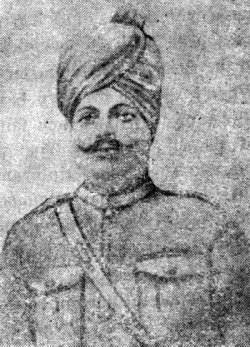
Risaldar Badlu Singh VC 14 Murrays Jat Lancers Erstwhile 29 Lancers: He was from village Dhakla district Rohtak. In 1916, he went in a new draft to 29 Lancers in France. It became necessary to launch a frontal attack of the Cavalry Brigade on the heavily wired German Position. The Brigade consisted of 20 lancers. Jodhpur Lancers and 29 lancers. The ground was rough and wet with recent rains. It was a foggy morning. German machine guns on the left flank were menacing. Risaldar Badlu Singh's troop was on this flank.
The advance commenced at the trot, Risaldar Badlu Singh on his own, increased the pace of the troop, galloped out of the brigade line and charged the machine gun positions. Before the attack went in he had silenced the machine gun, killed a number of gunners and captured 50. Half of his troop was also killed including himself. He was awarded the Victoria Cross Posthumously.
6th Battalion, The Jat Regiment

6 Jat earned a great name in France. German troops used to abandon their positions whenever they heard the Jat war cry. The battalion had a number of wrestlers and was well known for its wrestling and tug-of-war teams. The wrestling team was famous for a rare act. When they assaulted an enemy position they would thrust the bayonet in the enemy and throw him out from the trench like a rag. Their best wrestler was Subedar Neki Ram Dalal of village Mandothi [Rohtak], now in district Jhajjar and number two was Harphul Singh of Maiyna [Rohtak]. Sixth Jat remained in trenches four years and there were a lot of casualties.
History of the Jats, End of Page-228
The battalion never knew a failure irrespective of the losses. They were almost written off three times. German prisoners of war used to ask whether it was 6th Jat Battalion or a Brigade.
Once 6th Jat was relieved for regrouping by Cavalry Brigade. As soon as the Germans came to know of it they advanced and threatened both flanks. 6th Jat was brought back. As soon as their war cries resounded in the air, the Germans withdrew. Subedar Neki Ram was killed in this action.
47 Sikh (Later 5 Sikh)
47 Sikh Sikh always kept a great name. During World War I, they fought in France in terrible weather conditions. 300 all ranks were killed and 2174 got frost bitten by long exposure.
Major Prakash Singh: VC
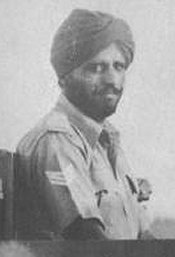
Hav Maj (now Major) Prakash Singh VC: In 1944, his Battalion was fighting along the Coast of Arakan, Southeast Asia. In a battle, the MG battalion which was with them suffered very heavy casualties. A number of carriers were abandoned with wounded British soldiers still inside. These were under heavy enemy fire and could not be recovered. Maj. Prakash Singh went forward on a truck. When fire came, the British driver of the truck ran away. Single handed and regardless of the bullets, Prakash Singh started collecting the causalities which included a British Officer. When he was pulling a carrier with the chain, he saw a company of the enemy advancing towards him. He un-clamped an M M G from the carrier and fired. The company stopped coming. Later, 70 dead were counted. Prakash Singh brought back all the wounded.
A British General happened to see all this. Prakash Singh was awarded the Victoria Cross.
Subedar Richhapal Ram Lamba
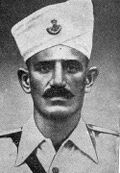
Subedar Richhpal Ram 4/6 Rajputana Rifles: He was from village Dalanwas district Mahendragarh.
History of the Jats, End of Page-229
From 7th Feb. to 12 Feb. 1941 he displayed consistent bravery on Karen front in Italy. He was company second-in-command. In an attack on the night of 7 Feb. on his own request he went with the leading platoon. With 30 men he assaulted the enemy position. He himself went for the Machine Gun position, killed the gunners and snatched the Machine Gun. The company Commander was wounded and Richhpal Ram took over command. From 12 O'clock to 4.30 p.m. he warded off six attacks. On 12 Feb. his company again attacked. One of his legs was blown off but he kept advancing and urging his men till he died of excessive bleeding. He was awarded posthumous VC.
CHM Chhailu Ram: VC
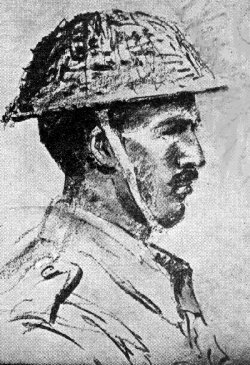
CHM Chhailu Ram VC 4/6 Rajputana Rifles: He displayed exceptional courage on 19 and 20 Apr. 1943 in Greece. He was with the leading company in the attack. Enemy machine guns which were sited on higher ground made further advance impossible. Chhailu Ram took his Tomy Gun, went single handed for the machine guns and silenced them. Advance was resumed. The Company Commander was wounded. He evacuated him after first aid and took command of the company. He also gathered the remnants of the badly mauled Mohammedan company. Ammunition was exhausted. Enemy intensified their attack. Chhailu Ram ordered a bayonet charge and with personal example and constant urging threw out the enemy. He had been wounded earlier. Awarded posthumous VC.
Lance Naik Karam Singh - PVC
Lance Naik Karam Singh VC was born on September 15, 1915 in an agriculturalist family of Sikhs in the village of Mallianwala1 in the Sangrur district of Punjab. When he was six years old, he was sent to school, but it was impossible to educate Karam singh, his father sent him to work on
1. His permanent address is : Vill. Mallian, via Shaina, Barnala, Punjab: 148103, India (http://twdi.in/node/493)
History of the Jats, End of Page-230
the farms. But he had no liking for agriculture either. He was given up as spoilt child.
From his very boyhood, he pined for an adventurous life. He had great admiration for his uncle who was a Junior Commissioned officer in the army. Karam Singh's ambition was to be a soldier. This was evidenced in his liking for wrestling and other strenuous games in the village. It was on September 15, 1941 that an opening for an adventurous life presented itself. The second World Was in full swing. The inevitable Recruiting Officer visited Karam singh's village. Karam Singh, now a youth of 26 years, volunteered to get enrolled in the Army.
Having completed his basic training at the Sikh Regimental Centre in Naushera, Karam Singh was posted to the first Battalion of Sikh Regiment in August 1942. The Unit was then carrying out an intensive military training at Ranchi. It was during the training that his officers came to know that Karam Singh possessed the qualities of leadership and drive and could take quick and correct decisions in emergencies.
In 1944, the unit was detailed to fight with the Japanese on the Arakan front. Karam Singh got the long cherished opportunity to display his dash and strength. He risked his life on a number of occasions while fighting with the Japanese on the Htinshbyin, Buthidaung and Manipur fronts. He was wounded as many as four times in the Burma campaign. For his outstanding feats of bravery, Karam Singh was invested with the coveted Military Medal on March 14, 1944. He was subsequently promoted to the rank of Lance Naik.
The war ended in 1945. India became independent two years later. But peace in free India was disturbed
History of the Jats, End of Page-231
when Pakistani raiders invaded Jammu and Kashmir in 1947. It was October , our men routed the invaders beyond Tithwal, a small town in West Kashmir. The first Battalion of the Sikh Regiment was dispatched there to defend the town. The enemy fanned out in the neighbourhood and made desperate attempts to break through our resistance line. But the Sikh grimly held out.
A number of pickets were organised for the defence of the town. Lance Naik Karam Singh was detailed to guard a strategic outpost high on a hill, with only three of his comrades. Behind the picket was his company holding some bunkers, while in front was a heavy concentration of enemy. To attack the main position the company was holding, the enemy had first to capture the outpost.
On October 13, 1948 the day broke with war cries. Well entrenched in decisively advantageous positions, the enemy in overwhelming numbers attacked the outpost. Though outnumbered by one to ten Karam singh with great courage and determination put up dogged resistance. One of his colleagues fell down wounded in the engagement. But the attack was successfully repelled.
There was a brief lull. Soon the enemy mounted another offensive. This time it was fierce fight between a host of invaders and three brave souls. Another comrade fell. Still the Lance Naik held out. Quite oblivious of the injuries he had received all over the body in the encounter, he used all the weapons he could lay his hands upon to hold his post. The stock of ammunition, he discovered was fast running out. He looked back to the main position for help. The bunkers were far off. His wounded comrades, he found, were dying. He too was loosing strength by profuse bleeding. The enemy was advancing in surging waves towards the outpost from all
History of the Jats, End of Page-232
three sides. Karam Singh decided to withdraw. He safely carried his wounded comrades to a position of safety in the rear through heavy artillery fire, engaging the enemy in a hand to hand hand grenade fight all the way. During the heroic withdrawal, Karam Singh wiped out two enemy stations.It was a tale of cold courage and amazing fortitude.
Although badly injured and exhausted in the encounter, Karam Singh immediately joined that section of the Platoon which was nearest to the enemy. Another bloody skirmish ensued. The raiders started shelling very heavily.Not a bunker of the Lance Naik's platoon was intact. The crawl trenches got filled up. His men were falling fast. Maintaining a steady fire on the enemy positions, he moved from post to post. While doing this, he was hit by a chance bullet. But this did not stop hi. There was not a single bunker in which he was not seen encouraging the unhurt and tending the wounded. This kept his men in high spirits. By midday, the raiders had attacked as many as four times, but Karam Singh had been ready for them every time. They were beaten off.
Battle cries again ! The attackers mounted the fifth offensive with renewed ferocity. In the encounter Karam Singh spotted two raiders advancing towards him through crawl trenches. They could not be engaged by fire. Time was running out fast. The contingency demanded a split second decision. Karam Singh jumped out of his trench, bayoneted both of them and returned to his position in a trice. This was broke the morale of enemy completely. The attack was repulsed. The invaders fled.
But soon they returned. They launched two more attacks, but in vain The day long battle ended when the enemy called off the offensive at night. They finally withdrew, paying a heavy toll.
History of the Jats, End of Page-233
Throughout the engagement, the attackers fired about three thousand shells, but they could not shake Karam Singh off his post. Thithwal was saved. The victory earned here was one of the decisive victories in the Jammu and Kashmir campaign. The Battle of Thithwal is saga of outstanding gallantry on the part of a soldier who fought an enemy host almost single handed.
Befitting his feats of bravery and sincere devotion to duty, Lance Naik Karam Singh was decorated with the Param Vir Chakra,India's highest gallantry award.
Maj Gen Rajinder Singh Sparrow
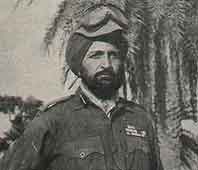
Lt. Colonel [Later Maj Gen] Rajender Singh (Sparrow) MVC Bar: In 1948, Pakistani invaders occupied the 11000 ft high Zoji La Pass. It was found difficult to dislodge them. Major General K S Thimayya, DSO decided to send tanks to surprise the enemy. Lt. Col. Rajinder Singh, CO of 7th Light Cavalry achieved the unique task of taking his tanks on the pass in spite of overwhelming odds. The enemy was completely surprised and abandoned the pass. This was a record of highest altitude for employment to tanks. Lt. Col Rajinder Singh was awarded M V C.
During the Pakistan aggression in 1965 Maj Gen Rajinder Singh Sparrow was General Officer Commanding I Armoured Division. As a result of his brilliant handling of the Division, Pakistani Armoured Corps, pride of Pakistan Army was defeated. Major General Rajinder Singh got a bar to his Maha Vir Chakra.
Major Risal Singh
Major Risal Singh, MC, 3/9 The Jat Regiment: My son who was commissioned in 1938. In 1940 his battalion was in the Middle East. Once his battalion was surrounded by Germans. He deployed his
History of the Jats, End of Page-234
Machine Gun Company, in the most threatened position and enabled the battalion to withdraw. His position was overrun. When the Germans came near he feigned death, and escaped detection. Once they had passed he started his carrier and managed to escape.
On his return from the Middle East he was posted to Army Headquarters but [he] volunteered to go with his Battalion to Burma, with 5h Indian infantry Division.
At Mauglaw, he led a brilliant company attack and in hand to hand fighting, both sides suffered heavily, and the enemy had to withdraw. During this action Major Risal Singh was wounded by an enemy hand grenade. He was awarded the Military Cross and two of his Havildars; (Non commissioned Officers) were awarded Military medals.
During the 5th Indian Divisions advance form Imphal to Kohima to link up with the garrison there, the famous feature Singhbhum was help by the enemy and a brigade-sized attack was being proposed. Major Risal Singh took out a strong Patrol to find out the strength of the enemy dispositions. He found that the feature was not as strongly defended as had been reported. He on his owns initiative carried out an attack and captured Singhbhum. He was wounded again but refused to be evacuated beyond the MDS. He was awarded a Bar to his Military Cross for this action.
The Battalion attacked the hilly trenches of the enemy on the Imphal Kohima road, on June 20th but the enemy repulsed the attack with heavy casualties to the ‘A’ Coy of the Jats. The enemy position was again attacked on June 21. ‘B’ Coy of the Jats under the command of Major Risal Singh was in front of special Ni.1 picket. The machine guns of the enemy were silenced and captured. At the moment when Major Risal Singh was planning a further advance he was hit by machine gun fire on the head and gave his life bravely. The Commanding Officer
History of the Jats, End of Page-235
Col. Girty recommended his name for the ward of a Victoria Cross but that was not to materialize. Commanding Officer Girty sent a condolence letter as follows:
- "You will be distressed to know, but being a veteran you will compose yourself that your son, Major Risal Singh, has died for a noble cause in performing the sacred duty. I have lost one of my trustworthy companions. I have not seen such a gallant man, as Risal Singh in my service, which never cared for his life while doing his duty. There has been a great vacuum in the Battalion which cannot be filled by British or Indian Officers."
Brigadier Hoshiar Singh
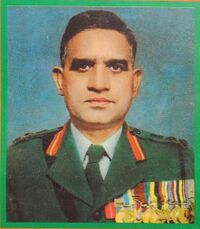
Brigadier Hoshiar Singh, IOM, IDSM Rathi, Village Sankhol, District Jhajjar joined the Rajputana Rifles as a recruit in October 1934 when he was barely 18 years old. He was promoted to the rank of Jamadar in December 1940. As a Junior Commissioned Officer [when known as VCO] he served with distinction in the Middle East with 4th Battalion [Outram's] . The Rajputana Rifles and won the IOM, IDSM and CROIX DE GUERRE [French Decoration] for bravery on the Battle field. He was twice mentioned in despatches for meritorious service. In 1941 he was selected for a commission and passed out from the Indian Military Academy, Dehra Dun.
Personal Account by Brigadier [then Jamadar] Hoshiar Singh of his escape from Mezze:
Colonel JONES sent for me at about 1900 hrs. 19th June and told me that he had a special job for me. After giving me a peg of whisky he explained the whole situation as he wanted a verbal message to be sent to the Brigade. The Brigade Major preferred a written
History of the Jats, End of Page-236
message and wrote down the whole situation, avoiding words which might give information to the enemy, as he thought that my escape was impossible . Two other Officers and 2/Lt Cordwell were to accompany me. The three of us equipped ourselves with a water bottle and a revolver and decided to leave the perimeter as soon as it was dark.
At 2045 hrs after saying goodbye to all we got outside the perimeter through a hole in the wall and crept into adjoining garden. I decided to swim across a stream which ran along side the western perimeter wall. A tank was just on our left and when it was busy in firing at the wall, we got into an outer garden. Creeping along the garden wall we got into the village itself. There were not many enemy in the village, but the tanks, armoured cars and infantry were patrolling in the streets and bigger lanes.
After crossing the main street we got on the roof of a low house and jumped down into a narrow lane. Unfortunately as I got down I hurt my right leg and for some time it seemed as if I would be unable to walk. But leaning on my companions, we turned our course towards the woods. All the time we kept along the walls, but before reaching a garden wall an enemy post was encountered and the sentry fired a rifle from about 20 yards. None of us were hit and we ran back. we tried another way and this was safe.Having got over the wall into a garden we quenched our thirst and thought ourselves a bit safer. It was now 2200 hrs. we could hear tremendous firing behind us and could actually see a counter attack on the 2/1st Punjab Company on the hill. The three of us felt almost happy. at 2325 hrs we left the garden and struck into the open, making steady progress along the hills. Nothing important happened until we reached the area where we expected to meet the Royal Fusiliers Company at 0330 hours. 2/Lieut Cordwell called out 'Fusiliers', 'Fusiliers' but nobody replied. We decided to continue our march to Brigade Headquarters, still two miles further on. Fortunately,
History of the Jats, End of Page-237
on our way we found a truck and reported to the staff captain at 0300 hrs.
The Brigadier arrived and took immediate steps to send help to the besieged garrison.
The Indian Order of Merit [2nd Class] :
Extracts from citation for the above award to Brigadier [then Jemadar] Hoshiar Singh :
"This Viceroy's Commissioned Officer was conspicuous for his gallantry and devotion to duty when acting as Intelligence Jemadar during operations from 7th Feb 1941 to 27 Mar 1941. Apart from a fierce battle fought at such a high altitude in military history his normal duties of guiding the battalion during many moves by and night which duties he carried out calmly and confidently he did invaluable work in collecting scattered portions of the battalion during a night attack on 7th/8th Feb, and in observing and reporting on the situation,
He established an Observation Post after the capture of 'B' Company's objective and remained there in observation returning with valuable information only after 'B' Company had been forced to withdraw.
Jemadar Hoshiar Singh again manned an Observation Post during an attack on the 15th Mar 1941 and maintained his position and continued to send valuable information even though his O.P received a direct hit from an Artillery shell. During an attack on the 16th March 1041, he was again conspiccous in his efforts to ascertain the situation, and his services were invaluable in guiding the battalion when it withdrew from its position.
His calm, confident bearing and disregard for personal danger under fire were outstanding throughout
History of the Jats, End of Page-238
and were a great encouragement to all who saw him."
Brigadier Hoshiar Singh and Chinese War: When the Chinese began their massive invasion of NEFA and the situation over there was precarious,the forty six yeas old Brigadier Hoshiar Singh was selected at a short notice to take over the command of 62 Infantry Brigade at Seila on 28 (29) October 1962. Under his able leadership, the Brigade held up the enemy's advance for three days. It was only on receipt of orders from higher headquarters, that he reluctantly pulled out his Brigade and started the withdrawal. In the meantime,the Chinese had declared an unilateral ceasefire and the Brigadier and his party were withdrawing they were treacherously ambushed by the Chinese on 27 November 1962 and the gallant Brigadier fell to a Chinese bullet.
Major Shaitan Singh's Company of Ahirs
The company of Ahirs from 13 Battalion The Kumaon Regiment commanded by Major Shaitan Singh was deployed astride the road for the defence of Chushul (Ladakh). This position was at the height of 18,000 feet from the sea level. The temperature was 40 degree below zero. The weather was extremely inclement and uncongenial. The aim of the Chinese troops was to capture the important position of Chushul. So they mounted a fierce attack on Chushul with heavy mortars and automatic weapons in large strength. The Ahir Jawans of Kumaon Regiment put up aa stout resistance which shattered away the high hopes of the enemy. Major Shaitan Singh boosted the morale of his Jawans by reaching every 'bunker'. Due to heavy casualties the company continued to become under strength so much so that in one bunker, there remained only one Jawan who was manning communication. Major Shaitan Singh reached to support this Jawan who was profusely bleeding due to
History of the Jats, End of Page-239
wounds. Major Shaitan Singh loaded one Light Machine Gun and handed it over to that Jawan by which the Jawan's morale became much higher and he firmly held his post. After that he moved to the next bunker to back up his Jawans. In the meantime he was wounded by an enemy bullet on his left arm, but the Major bounced forward undeterred by squeezing his wounded army by his right hand. In the mean time, the enemy shell exploded near him and the splinters pierced in his stomach where he fell down badly wounded. In spite of all this he advised his Jawans not to come to his support, but continue their task of driving the enemy away. At the time of his martyrdom, he asked his Jawans to let him lie there in devotion to his duty. Nearly whole of the Company died fighting. 90 dead bodies were later found in various fighting postures. This was a rare example of such a fierce battle fought at such a high altitude in Military History.
Maj Gen Budh Singh
Captain now Maj Gen Budh Singh M.C. and Bar is of Dahiya gotra and hails from village Bhatgaon district Rohtak.
During World War II, he was Coy Commander of a Punjab Regiment and in Burma. His company was holding a difficult defensive position. The enemy shelled the whole night and then launched fierce attacks. Budh Singh kept up the morale of his company and held on to the position. He was awarded M.C.
Later his company was ordered to attack a pass. They encountered very heavy Machine Gun fire from a dominating position. The company suffered heavy casualties, Budh Singh himself was wounded. He however managed to conduct organised withdrawal. He got a Bar to his MC.
During the Chinese invasion in 1962, Major General Budh Singh was GOC of a Division in Ladakh.
History of the Jats, End of Page-240
Indo Pak Conflict
During this conflict, a large number of senior Jat officers proved themselves to be outstanding commanders. Notable amongst these are described below :
Air Chief Marshal Arjan Singh
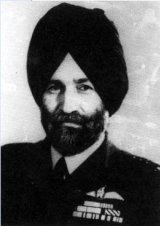
Air Chief Marshal Arjan Singh Aulakh, DFC Padma Vibhushan, was born on 15 April 1919 at Lyallpur. His gotra is Aulakh and his village is Kohali in district Amritsar. He got commissioned in the Royal Air force in 1939. He won a DFC for successful command of a squadron in Burma in 1945.
In 1963, he became Chief of the Air Staff, the highest rank attained by a Jat in the three services.
His handling of the Indian Air Force during the Indo Pak conflict of 1965 won him world wide fame and the Padam Vibhushan. By personal example he infused a spirit of daring in his young pilots who hunted the enemy Saber Jets with their Gnats. They destroyed enemy strongholds and blunted their armoured division by destroying 14 Pattons in one attack.
They destroyed an enemy train carrying important equipment. Enemy lost 70 aeroplanes against our 35. Under the able guidance of Air Chief Marshal Arjan Singh the Indian Air Force gained a place of pride amongst the Air Forces of the world.
Lt. Gen. Harbaksh Singh, Vr. C. Padma Vibhushan
Lt Gen. Harbaksh Singh was born in Sangrur in 1913 and got commission in 1935. He took active part in the Second World War and was seriously wounded in Malaya in 1942.
During 1965 conflict he was responsible for all
History of the Jats, End of Page-241
operations against Pakistan as GOC-in-C Western Command.It was his drive and strategic ability which made the Indian army knock out the pride of Pakistan Army.
Lt. Gen. Joginder Singh Dhillon
Lt. Gen. Joginder Singh Dhillon was born on 19 November 1914 and was commissioned in Bengal Engineers in 1936.
During 1965, he was GOC XI Corps which won all the victories in the Punjab.
Major General Swarup Singh Kalan: MC, MVC
Major General Swarup Singh Kalan is from village Salhawas district Rohtak [Now Jhajjar district, Haryana] and of Jakhar gotra. During the period from the 5th August to 22nd September 1965, Major General Swarup Singh Kalan was in Command of our troops in the Uri-Baramula-Gulmarg-Tithwal sectors. The first report of Pakistani infiltration was received in his area. Major General Swarup Singh planned and executed operations to hunt the infiltrators, capture their bases and block routes of infiltration in the entire territory east of the Kishan Ganga.
For the capture the Hajipur Pass and the subsequent link-up towards Poonch, he personally led his troops against the well entrenched regular Pakistan Army posts which had been strengthened by the enemy for the last 18 years. Inspired by his leadership and courage in the face of enemy fire, the troops under his command threw the enemy forces out of their well defended positions. Though out of operations, Major Swarup Singh Kalaan displayed conspicuous courage and exemplary leadership in the best traditions of the Indian Army.
Maj Gen Khem Karan Singh - MVC
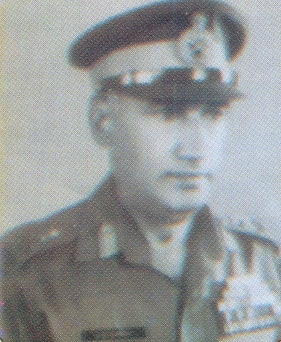
Brigadier Khem Karan Singh is from village Bhadani in Rohtak district.
History of the Jats, End of Page-242
Brigadier Khem Karan Singh, commander of an armoured brigade, led his brigade into action during the operations in the Sialkot sector from the 6th to 22nd September 1965. In addition to his own integral armoured Brigadier Khem Karan Singh was given command of additional armoured units in order to cope with enemy tanks which were superior in number and better in technical performance. During the first three days of battle, the force under the command of Brigadier Khem Karan Singh destroyed over 75 enemy tanks at the cost of a small number of our own tanks. This was possible to Brigadier Khem Karan singh's personal example as he, in his own tank, was present at the point of maximum enemy threat.
Brigadier Khem Karan Singh fought the battle of Phillora for three days and nights. Finally, because of his superior leadership, better tactical and technical performance and the firm determination of our troops, the enemy force was defeated and was thrown out of this important communication centre.
The task assigned to his formation in the initial stages was to destroy as much enemy equipment as possible;it was performed so well that the enemy had to move up all reserves in order to hold the line. A few days before the cease fire the enemy tanks commanders were so demoralised that they avoided close combat and engaged our forces only at extreme range.
Brigadier Khem Karan Singh displayed outstanding leadership, high tactical ability and great devotion to duty in the best tradition of the Indian Army.
Major General H.S. Gahlaut
He is my (Ram Sarup Joon's) Son-in-law, and belongs to village Nangloi in Delhi State. He has been an outstanding sportsman and was Captain of All India Volley Ball
History of the Jats, End of Page-243
team from 11939 to 1942. He served with distinction in World War II and severely wounded in action.
In the field of sports, once, while at Dehradun, he had a hand to hand fight with a wounded tiger, killed it but was badly mauled himself.
He took part in Indo Pak war of September 1965 as Brigade Commander 62 Mountain Brigade. His brigade attacked and captured the Roh Nala Bund in Pakistan opposite to Kasur. However next day, the Pakistan 1st Armoured Division counterattacked with the aim of reaching Beas along axis Khem Karan, Bhikhi Wind, Khem Karan and Patti. The Brigade fought a very gallant action at the road junction of Asal Uttar and defeated Pakistan's Armoured Division destroying 40 Patton tanks.
Lieutenant Colonel Dal Singh
My son Lieutenant Colonel Dal Singh also contributed to the war efforts in his minor position. He was a Company Commander in 8 Kumaon in Chowkibal area in Jammu and Kashmir.His battalion bore the first burn of the infiltrators and were subjected to major raids on 7th August and 13August 1965. In the latter his CO was killed and 2IC seriously wounded. Major Dal Singh assumed command of the battalion, retrieved a precarious situation, established two important posts dominating Pakistan occupied Kashmir territory and commanded the battalion successfully through a difficult period.
Captain Kanwar Jasbir Singh
Captain Kanwar Jasbir Singh son of Maj. Gen. Jang Shmsher Singh of village Bahu Akbarpur district Rohtak joined 17 Poona House on 16 December 1961. From 8 September 1965 to 16 September 1965 he participated in the battles of Libba, Phillora, Wazirwali, Jassoran,
History of the Jats, End of Page-244
Chawinda and Buttai Durgandi and Signal Officer of the Regiment under late Lt. Col. A B Tarapore PVC. On 16 Sep. 65 he was hit by an enemy shell and later died. For his gallant and distinguished service in this operation, he was mentioned in Despatches.
Famous Battles
Armour Battle: Times correspondent wrote in his first article after the Pakistani invasion of Chhamb Jaurian 'India is contemplating the use of its Armoured Division; but they were better beware because their out dated Centurians are no math to the sophisticated Pattons of Pakistan.'
It is also on the strength of those Pattons that Ayub Khan had boasted that he would stroll up to Delhi.
What actually happened is well know. 97 Pattons lying in what was named as Patton Nagar and an equal number lying scattered in Phillora and other areas of Sialkot sector, is an irrefutable evidence.
Finally it was not the tank that mattered but the man inside it. And most of these men were Jats as they provide a majority of men for the Indian Armoured Corps. Moreover, the chain of command had most Jat links: Army Commander Lt. Gen. Harbaksh Singh, Corps Commander Lt. Gen. J S Dhillon, Divisional Commander Maj. Gen. Rajinder Singh and Armoured Brigade Commander Brigadier Khem Karan Singh. And they had the air support from Air Chief Marshal Arjan Singh.
Infantry Battles: The two memorable battles in Punjab, Burki and Dograi, were both fought by Jats, the former by Sikh Jats and the latter by Hindu Jats.
History of the Jats, End of Page-245
Battle of Burki: The battalion that took part were Punjab, under Lt. Col. Bhullar (Jat) and Sikh under Lt Col Sidhu and latter Lt. Col. S.S. Minhas (both Jats). Two companies of Punjab started advancing towards Burki and came under heavy shelling and tank fire. The Jawans kept advancing undaunted till they closed in with the steel and concrete pill boxes of the Pakistanis. The only way to surmount these was to crawl up and physically destroy. them. And that is what the boys did. They threw hand grenades inside the pill boxes and snatched their guns.They reached the canal bridge but unfortunately the enemy had already demolished it.
The Sikh started advancing at 8.00 P.M. under cover of Artillery fire with the objective as Burki. Half way to the objective the Sikhs shouted Sat Sri Akal which almost drowned the din of enemy shelling, and carried on till they captured Burki.
Subedar [then Hav.] Ajmer Singh Vr.C told "just 30 yards short of Burki we came under very heavy machine gun fire. Major Shamsher Singh ordered me to go from flank and eliminate the fire. I took two men, crawled upto enemy emplacement, threw a hand grenade, killed the gun team and started using it on the enemy. The platoon resumed advance and hunted the enemy from houses. we started digging. At some distance enemy shouted Allah Hu Akbar. We shouted Sat Sri Akal and nothing was herd thereafter."
Major Dalip Singh Sandhu was in the command of the follow up company. He ordered Subedar Gurdev Singh to clean up an enemy banker which had come to life. Subedar Gurdev Singh himself crawled up accompanied by three men, threw two grenades in the
History of the Jats, End of Page-246
bunker, killed the whole crew except one who was captured and also seized the gun.
Lance Naik, Pritam Singh, Lance Naik Shamsher Singh, Hav. Ajmer Singh of the Sikh Battalion and Sep. Bal Ram and Sep. Gurnam Singh of the Punjab Battalion did similar acts of bravery and destroyed enemy pill boxes one by one till the enemy position fell. Lance Naik Pritam Singh carried out his task even after being severely wounded.He died later and was awarded Vr. C. posthumously.
Battle of Dograi by 3 Jat: This was a unique achievement by Third Battalion, The Jat regiment, which achieved results which should normally require a brigade or more. They defeated a complete and good enemy battalion in well prepared defences in built up area and steel and concrete pill boxes. The battalion knew well that success would be very costly so, they had a Bara Khana before going into attack with a view to having a last good meal.
The attack started on the night of 21st September. A part of battalion engaged the enemy with frontal fire while the remaining took a long detour of 6000 yards and approached from East. It was dark night. The advancing troops came across dense mine fields and heavy machine gun fire on fixed lines. The Commanding Officer Lt. Col. Hyde had foreseen it, warned the troops of what they were going to encounter and had ordered that every man would keep going forward, crawling if necessary, till he either dies or reaches the enemy positions. The Jats carried out his orders to the last word. Hand to hand fight carried on till day break. In the morning 300 Pakistani dead were counted. 109 including their Commanding Officer
History of the Jats, End of Page-247
were made prisoners. A complete battalion had been written off, the order of battle of Pakistan Army and also and important place was captured. Numerous individual examples of courage had been set for posterity.
Only 27 survived out of the company commanded by Major S.R. Yadav.
The Second company commanded by Major Raghbir Singh Sandhu had the honour of killing 12 and capturing 29 Pakistanis including Lt. Col. Golwala the Commanding Officer.
Major Asha Ram Tyagi was found with six bullets in him. He had captured two Pakistani Tanks. He died with a smiling good bye to the second in command.He was awarded MVC posthumously.
Naik Manphool Singh killed 10 with his bayonet.
Subedar Pale Ram who earned M.M. for killing 89 Japanese during second world war did it again. He kept advancing with his platoon in spite of getting 7 bullets in his stomach till his troops captured their objective and 4 enemy machine guns. In spite of his condition,he killed several enemy with his bayonet and survived.
Hav. Hukam Singh killed 7 enemy and captured 24 from a house.
Sep. Kanwar Lal, the CO's batman saw that enemy was endangering the CO by their fire from inside a house.He ran towards them and killed 3 with a grenade. Two Jawans were found lying next to the enemy banker with grenades still in their hands.
Hav. Randhir Singh was found with his face almost inside the enemy pill box and 20 bullet holes in his head.
History of the Jats, End of Page-248
Sep. Mahabir Singh kicked an enemy in the face when he was trying to grab his gun and then bayonetted him.
Lt. Col. Hayde, the CO, kept up with the assaulting troops and never took cover. He was awarded MVC for his brilliant command.
According to the Battalion Doctor, Captain S.G. Reddy, he never heard a wounded Jat saying 'AH' while getting his wounds dressed.
In the words of the captured Pakistani Lt. Col. Golwala, " There was just no way of stopping the Jats."
History of the Jats, End of Page-249
References
Back to Books on Jat History

